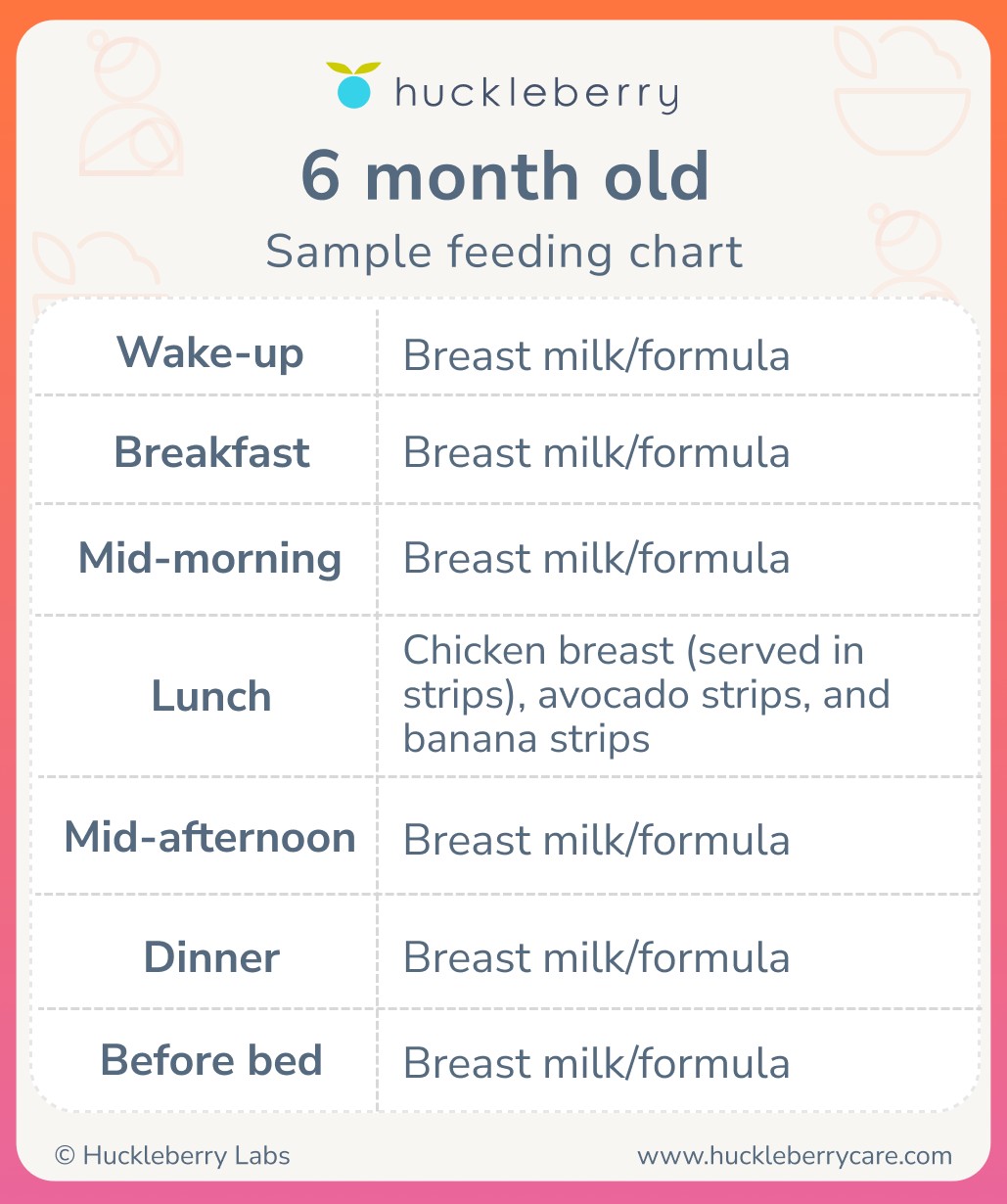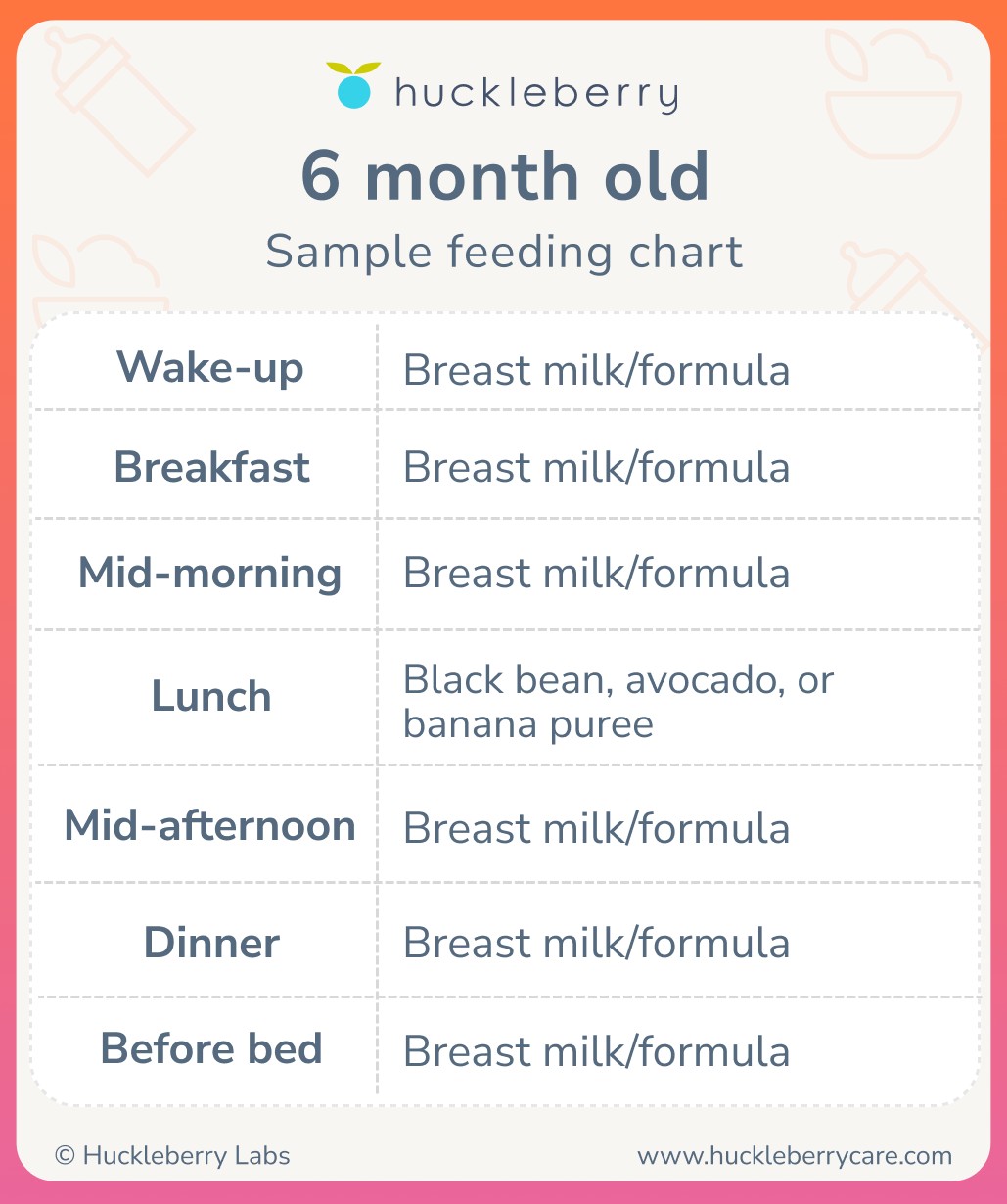Introducing solids to your six-month-old is a significant milestone, filled with both excitement and questions. As your baby transitions from solely breast milk or formula to exploring new flavors and textures, understanding their nutritional needs becomes crucial. This guide provides a comprehensive overview of how much your six-month-old should eat, covering both breast milk/formula and solid foods.
6-Month-Old Baby Sample Feeding Schedule
Keep in mind that every baby is different and their individual needs may vary. The sample schedule below should be considered a guide, not a rigid plan.
| Time | Activity |
|---|---|
| 6:30 AM | Nurse or bottle (wake up) |
| 8:00 AM | Solid meal |
| 10:00 AM | Nurse or bottle |
| 1:30 PM | Nurse or bottle |
| 4:30 PM | Nurse or bottle |
| 6:30/7:00 PM | Nurse or bottle (before bed) |


How Much to Feed a 6-Month-Old: Food Chart
At six months, your baby will continue to rely on breast milk or formula as their primary source of nutrition while also beginning to explore solid foods. You can introduce solids in the form of purees or opt for a baby-led weaning approach. Regardless of your chosen method, your baby may start with one solid meal per day and gradually increase the frequency of meals and snacks as they approach their first birthday.
Most babies will continue to consume approximately 22-28 ounces of breast milk or formula per day, typically spread across 4-6 feedings. As long as your baby is growing well and producing around 4-6 wet diapers daily, they are likely getting sufficient nourishment. When it comes to solid foods, remember that babies at this age usually eat only small quantities. This might look like 1-2 tablespoons of purees or a few small bites of food when using the baby-led weaning method.
Baby-Led Weaning (BLW) Example
| Time | Food |
|---|---|
| Wake-up | Breast milk or formula |
| Breakfast | Breast milk or formula |
| Mid-morning | Breast milk or formula |
| Lunch | Chicken breast strips, avocado strips, banana strips |
| Mid-afternoon | Breast milk or formula |
| Dinner | Breast milk or formula |
| Before bed | Breast milk or formula |
Purees Example
| Time | Food |
|---|---|
| Wake-up | Breast milk or formula |
| Breakfast | Breast milk or formula |
| Mid-morning | Breast milk or formula |
| Lunch | Black bean, avocado, or banana puree |
| Mid-afternoon | Breast milk or formula |
| Dinner | Breast milk or formula |
| Before bed | Breast milk or formula |
7 Essential Tips for Feeding Your 6-Month-Old Baby
Navigating the world of feeding a six-month-old can be simplified with these helpful tips:
Tip #1: Maintain Consistent Liquid Feeds
While solid foods are being introduced, remember that breast milk or formula remains your baby’s primary source of nutrition. Don’t drastically reduce the amount of breast milk or formula offered.
Tip #2: Observe Hunger and Fullness Cues
Pay close attention to your baby’s cues, whether they are nursing, bottle-feeding, or eating solids. Feeding patterns can fluctuate, especially if your baby is experiencing discomfort from teething or a cold.
Tip #3: Recognize Signs of Readiness Before Starting Solids
Before introducing solids, ensure your baby exhibits signs of readiness, such as the ability to sit with minimal support, bring objects to their mouth, maintain good head and neck control, and show interest in food.
Tip #4: Introduce Solids Gradually
At this age, babies are naturally curious and may want to play with their food. There is no need to rush. Start with one solid meal per day and gradually increase the amount as your baby adjusts.
Tip #5: Prioritize Safety During Mealtimes
Always feed your baby in a securely supported high chair and never leave them unattended during meals. Serve food in appropriate sizes and consistencies to prevent choking hazards.
Tip #6: Focus on Essential Nutrients
Ensure your baby’s diet includes foods rich in iron, zinc, protein, and other vital nutrients. These nutrients are crucial for healthy growth and development at this stage.
Tip #7: Introduce Allergens Early and Often
Current research suggests that early and frequent introduction of high-risk allergen foods like peanuts, eggs, and dairy may help reduce the risk of food allergies. Unless advised otherwise by your pediatrician, include these foods in your baby’s diet.
Night Feedings for 6-Month-Olds
Many babies at this age can sleep for longer stretches at night. However, it’s perfectly normal for them to still require 1-2 night feedings. If your baby wakes up hungry, feed them as usual. Unless specifically instructed by your pediatrician, there is no need to wake your baby for feedings at this age.
Key Takeaways: Feeding Your 6-Month-Old
Feeding a six-month-old is an exciting yet potentially overwhelming experience. Remember that breast milk and/or formula are still essential, while solid foods are a new adventure. Take things slow, and remember that both you and your baby are learning during this new phase.
6-Month-Old Feeding Schedule: FAQs
Q: Can a 6-month-old drink water?
A: Yes, a 6-month-old can start to drink small amounts of water, ideally a few sips offered at mealtime from an open cup or straw cup. Avoid giving too much water throughout the day, as it can displace formula or breast milk.
Q: How often should a 6-month-old eat?
A: Many 6-month-olds eat approximately every 3-4 hours during the day. Breastfed babies may feed more frequently. It’s also common for babies at this age to wake up for 1-2 feedings at night.
Q: How long can a 6-month-old go between feeds?
A: It varies depending on the baby, but some babies can go 4-5 hours between feedings, especially if they’ve had a solid meal. Some 6-month-olds can also sleep for 7-8 hours at night without needing a feed. It’s best to follow your baby’s individual hunger and fullness cues.
Q: Can you drop night feeds at 6 months?
A: If your baby is consuming enough calories during the day and growing well, dropping night feeds might be possible. However, many babies still need 1-2 night feeds at this age. Consult with your pediatrician to determine if dropping night feeds is appropriate for your baby.
Q: Why is my 6-month-old eating less than usual?
A: There are various reasons why your 6-month-old might be eating less, such as teething, feeling unwell, or simply not being as hungry. As long as they are continuing to grow, there is usually no cause for concern.
Q: What is a 6-month nursing strike?
A: A nursing strike is when a baby suddenly refuses to breastfeed. This can occur for several reasons, including increased distractibility, teething, a stuffy nose, or an ear infection. Most nursing strikes resolve within 2-4 days.
Q: Is 30 oz too much for a 6-month-old?
A: Every baby’s feeding needs are unique and depend on their individual size and growth patterns. Typically, 6-month-olds consume around 22-28 oz per day, but slightly above or below that range is generally fine.
Q: Is 4 feeds a day enough for a 6-month-old?
A: Yes, 4 feeds a day can be sufficient for a 6-month-old as long as they are growing adequately and producing 4-6 wet diapers daily to ensure they are properly hydrated. At this age, many babies eat between 4-6 times a day.